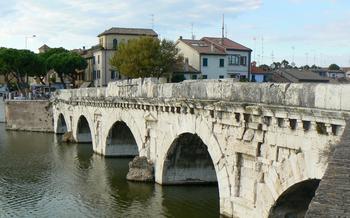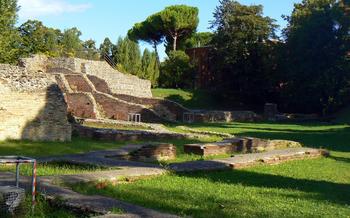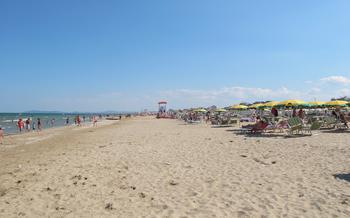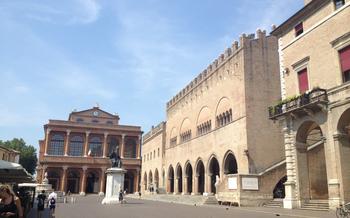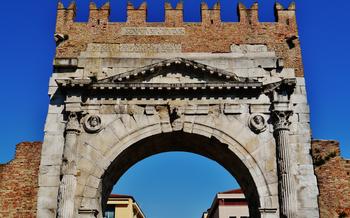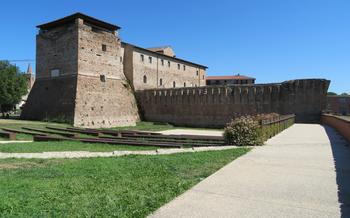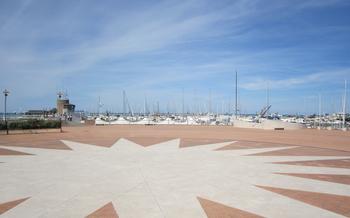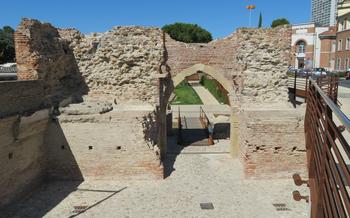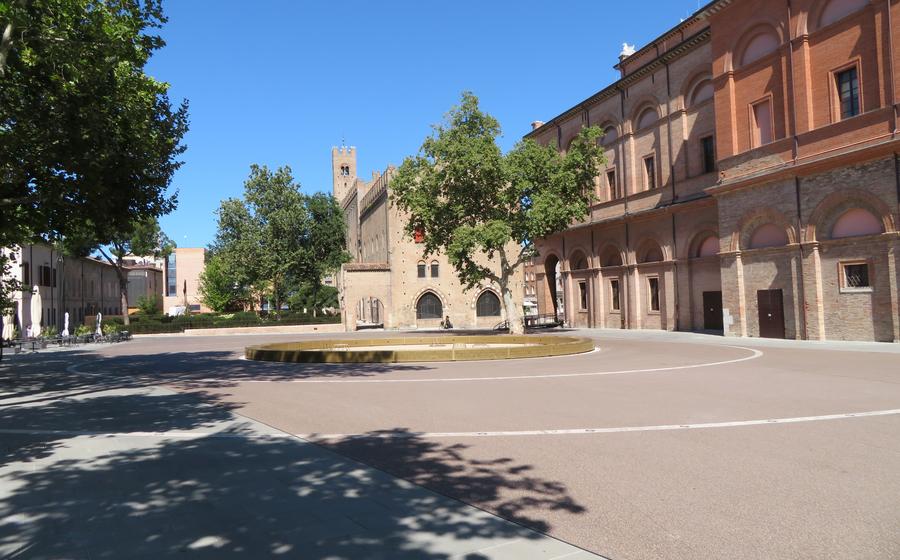
The Surgeon's House (Casa del Chirurgo)
- Introduction
- The Surgeon's House
- Mosaic Masterpieces: A Glimpse into Ancient Surgical Practices
- Interactive Exhibits
- Surgical Tools Showcase
- Pharmacy and Apothecary
- Interactive Workshops
- Ancient Laboratory
- Unique Artifacts
- Educational Programs
- Research Center
- Accessibility
- Thematic Tours
- Events and Exhibitions
- Insider's Tip:
Introduction
Nestled in the heart of the ancient city of Rimini, Italy, lies a hidden gem that transports visitors back in time to the world of ancient Roman medicine. The Surgeon's House (Casa del Chirurgo), an interactive museum dedicated to the life and work of the renowned Roman surgeon Eutyches, offers a unique and immersive experience into the medical practices and innovations of the Roman Empire.
Located in the heart of the city's historic center, the Surgeon's House is easily accessible by foot or public transportation. Step into this fascinating museum, and prepare to be captivated by the story of Eutyches, whose legacy continues to inspire and intrigue visitors from around the world.
The Surgeon's House
The Surgeon's House, known in Italian as Casa del Chirurgo, was once the property of a wealthy Roman surgeon named Eutyches, who lived in the city of Rimini during the 2nd century AD. This remarkable site is believed to have been his residence, as well as the place where he practiced his medical profession. It was excavated in the 1980s and has since been transformed into an interactive museum, providing visitors with a glimpse into the life and work of a Roman surgeon. The house features well-preserved rooms, including a surgery, a pharmacy, and a laboratory, all equipped with authentic tools and artifacts from the Roman era.
Mosaic Masterpieces: A Glimpse into Ancient Surgical Practices
Within the walls of the Surgeon's House lie exquisite mosaics that transport visitors back to a time when medicine and art intertwined. These intricate masterpieces, meticulously crafted by skilled mosaicists, depict surgical scenes with remarkable detail and symbolism. Each tile, carefully placed to form a cohesive narrative, tells a story of ancient medical practices and the expertise of the surgeon Eutyches.
One mosaic, particularly captivating, portrays a surgeon performing a complex operation on a patient. The precision and care depicted in the mosaic are a testament to the advanced surgical techniques employed by Eutyches and his contemporaries. Another mosaic showcases a variety of surgical instruments, each with its unique purpose and design. These intricate representations offer insights into the evolution of surgical tools and the ingenuity of ancient medical practitioners.
Beyond their technical prowess, the mosaics also carry symbolic meanings. They depict scenes of healing, compassion, and the triumph of medicine over adversity. The vibrant colors and intricate patterns captivate visitors, drawing them into the world of ancient Roman medicine and the remarkable legacy of Eutyches.
Interactive Exhibits
The Surgeon's House brings ancient Roman medicine to life through a range of interactive exhibits that engage visitors of all ages. Step into virtual reality experiences that transport you back in time, allowing you to witness surgical procedures as if you were there. Engage in hands-on activities and demonstrations, handling replicas of surgical instruments and exploring the intricacies of Roman medical practices. Multimedia presentations and educational displays provide in-depth insights into the world of ancient surgery, shedding light on the techniques, tools, and challenges faced by surgeons like Eutyches. These interactive exhibits offer a unique and immersive way to learn about the history of medicine and gain a deeper appreciation for the skill and expertise of ancient Roman surgeons.
Surgical Tools Showcase
The Casa del Chirurgo houses a remarkable collection of surgical tools and instruments that offer a glimpse into the advanced medical practices of ancient Rome. These tools, meticulously arranged in displays, provide insights into the surgical techniques and advancements of the time. Visitors can examine a variety of scalpels, forceps, probes, and other specialized instruments used by Eutyches and his contemporaries. Each tool is accompanied by detailed explanations of its function and significance, highlighting the ingenuity and skill of Roman surgeons. The showcase also traces the evolution of surgical techniques over time, showcasing how these tools have shaped the development of modern surgical practices. From basic instruments to specialized devices, the collection provides a tangible connection to the medical heritage of ancient Rome.
Pharmacy and Apothecary
At the Surgeon's House, visitors can delve into the fascinating world of ancient pharmacy and immerse themselves in the art of healing practiced by Roman physicians. A dedicated section of the museum showcases a remarkable collection of ancient medicines and remedies, providing a glimpse into the medical practices of the past.
Here, visitors can admire an array of medicinal plants and herbs meticulously preserved and displayed, just as they would have been in a Roman apothecary. Interactive exhibits allow visitors to explore the methods used to prepare and administer these natural remedies, offering insights into the ingenuity and knowledge of ancient healers.
The display also features replicas of Roman pharmaceutical tools and equipment, such as mortars and pestles, scales, and measuring cups, providing a tangible connection to the daily practices of ancient pharmacists. Visitors can learn about the processes involved in creating medicines, the challenges faced by Roman healers, and the remarkable contributions they made to the field of medicine.
Interactive Workshops
The Surgeon's House offers a unique opportunity for visitors to engage in hands-on activities and delve deeper into the world of ancient Roman medicine. Interactive workshops are conducted regularly, allowing visitors to handle surgical instruments, participate in simulated procedures, and test their knowledge through interactive quizzes and educational challenges.
These workshops provide a hands-on experience of what it might have been like to be a surgeon in ancient Rome. Visitors can learn about the different types of surgical instruments used by Eutyches and how they were used to perform various procedures. They can also try their hand at suturing and other basic surgical techniques.
The workshops are led by experienced educators who are passionate about sharing their knowledge of Roman medicine. They provide guidance and supervision, ensuring that visitors have a safe and enjoyable learning experience.
Whether you're a medical professional, a history buff, or simply someone with a curious mind, the interactive workshops at The Surgeon's House offer a fascinating and educational experience.
Ancient Laboratory
Step into the recreated laboratory where Eutyches, the renowned ancient Roman surgeon, once practiced his craft. This immersive space transports visitors back in time, offering a glimpse into the daily life of a surgeon during that era. Artifacts, tools, and materials used in Roman medicine are meticulously displayed, providing insights into the medical practices of the time.
Observe the intricate surgical instruments, herbal remedies, and anatomical models that Eutyches would have used. Discover the techniques and methodologies employed by Roman surgeons, who made significant contributions to the field of medicine despite the limitations of their time.
The ancient laboratory at the Surgeon's House is not merely an exhibition; it is an invitation to explore the fascinating world of ancient medicine and the extraordinary skills of Eutyches, whose legacy continues to inspire modern-day medical practitioners.
Unique Artifacts
Beyond the mosaics and surgical tools, the museum showcases a collection of unique artifacts that offer a glimpse into the personal and professional life of Eutyches and his contemporaries. These artifacts include personal belongings such as jewelry, clothing, and writing implements, providing insight into the daily life of a Roman surgeon. Rare medical instruments and artifacts, some of which are unique to the collection, shed light on the practices and techniques used by Eutyches and other Roman healers. Inscriptions and texts discovered during the excavations provide valuable information about the medical knowledge and practices of the time. These unique artifacts contribute to the overall narrative of the museum, offering a deeper understanding of the world of ancient Roman medicine.
Educational Programs
The Surgeon's House offers a range of educational programs designed to engage students, groups, and lifelong learners. Educational materials and resources are available for teachers and students to enhance their understanding of ancient Roman medicine. The museum collaborates with universities and research institutions to promote knowledge sharing and foster a deeper appreciation for the history of medicine.
Research Center
The Surgeon's House is not just a museum; it is also an active research center dedicated to the study of Roman medicine and archaeology. Scholars and experts from various fields collaborate to uncover the secrets of ancient medical practices and contribute to our understanding of the history of medicine. The museum's vast collection of artifacts, combined with ongoing research initiatives, makes it a valuable resource for scholars and students alike.
The research center conducts in-depth studies on a wide range of topics, including surgical techniques, pharmacological practices, and the role of medicine in Roman society. Through meticulous analysis of artifacts, texts, and archaeological evidence, researchers aim to reconstruct the daily life of Roman surgeons, their methods of treatment, and the challenges they faced.
One of the key areas of research focuses on the evolution of surgical instruments. By examining the design and functionality of the tools used by Eutyches and other Roman surgeons, researchers can gain insights into the development of surgical techniques and the level of medical knowledge during that period. This research contributes to a better understanding of the progress made in ancient medicine and its impact on modern surgical practices.
The research center also organizes workshops, conferences, and seminars to foster collaboration and knowledge sharing among scholars from different disciplines. These events provide a platform for researchers to present their findings, discuss new theories, and engage in interdisciplinary dialogue. The aim is to advance the field of Roman medicine and archaeology, and to promote a deeper understanding of the historical roots of modern medical practices.
Accessibility
The Surgeon's House is committed to providing an inclusive and accessible experience for all visitors. Wheelchair accessibility and ramps are available throughout the museum, ensuring that visitors with mobility impairments can navigate the space with ease. Braille signage and tactile exhibits are provided to enhance the experience for visually impaired visitors, allowing them to explore the museum's artifacts and history in a meaningful way. Audio guides and multilingual materials are also available to accommodate visitors from diverse backgrounds and language preferences, ensuring that everyone can learn and engage with the museum's exhibits.
Thematic Tours
Casa del Chirurgo offers a range of thematic tours that delve deeper into specific aspects of Roman medicine and culture. Led by experts in archaeology, history, or medicine, these tours provide a comprehensive exploration of various topics.
One popular tour focuses on the history of surgery in ancient Rome, showcasing the innovations and techniques developed by Eutyches and his contemporaries. Participants gain insights into the challenges faced by Roman surgeons, the treatments they performed, and the ethical considerations they grappled with.
Another tour centers on the role of medicinal plants and herbs in Roman medicine. Visitors learn about the diverse array of plants used for healing purposes, their properties and applications, and the methods employed to prepare and administer herbal remedies.
For those interested in medical ethics and the social implications of medicine in ancient Rome, a dedicated tour explores these themes. Participants examine the relationship between doctors and patients, the influence of social class and gender on medical care, and the ethical dilemmas faced by Roman physicians.
These thematic tours offer a unique opportunity to delve into the intricacies of Roman medicine and gain a deeper understanding of the practices and beliefs that shaped healthcare in the ancient world.
Events and Exhibitions
Casa del Chirurgo frequently hosts temporary exhibitions that showcase new discoveries and research findings in the field of Roman medicine and archaeology. These exhibitions often feature artifacts, documents, and multimedia presentations that shed light on various aspects of ancient medical practices, technologies, and beliefs.
In addition, the museum organizes public lectures, conferences, and workshops on a range of medical topics, from the history of surgery to the use of medicinal plants in antiquity. These events provide opportunities for visitors to learn from experts in the field, engage in discussions, and gain a deeper understanding of Roman medicine.
Casa del Chirurgo also collaborates with other museums and cultural institutions to organize special events and exhibitions. These collaborations often result in unique and innovative experiences that combine history, art, and science in captivating ways.
Whether you're a history buff, a medical professional, or simply someone with a curiosity for the past, Casa del Chirurgo's events and exhibitions offer a dynamic and engaging way to explore the fascinating world of ancient Roman medicine.
Insider's Tip:
For a hassle-free and enjoyable experience, book your tickets online in advance, particularly if you're visiting during the busy summer months. This will allow you to skip the queues and secure your spot. Take advantage of the cost-free guided tours that are offered at various times throughout the day. These tours provide insightful commentary and additional information that will enrich your visit. Don't miss the opportunity to explore the surrounding area, which is brimming with historical sites and attractions, including the Arch of Augustus, the Tiberius Bridge, and the Rimini Cathedral. Make a day of it and immerse yourself in the rich cultural heritage of this captivating city.
